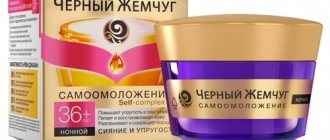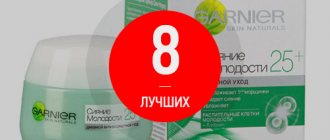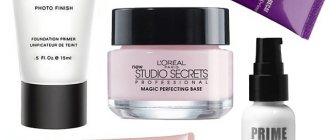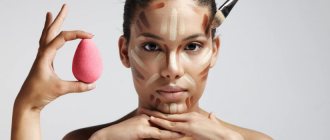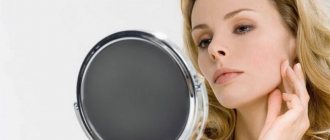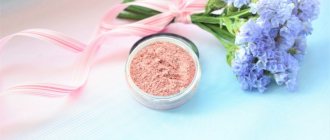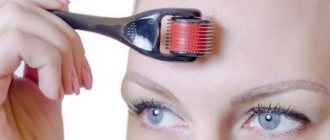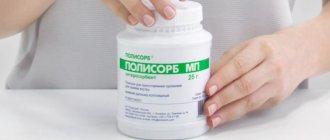The right concealer will help you instantly transform your face, refresh your skin and hide the consequences of sleepless nights. High-quality corrective products with a matte finish and reflective particles are presented in the line of many beauty brands. We'll tell you how to choose the right concealer to disguise skin imperfections and create flawless makeup.
- Texture
- Color
- Skin type
- Purpose
- Form
- Compound
- Additional features
- It is important to know
- Price
- Beauty brand
Texture
Deciding on a convenient concealer texture
Concealers are available in various textures, so when choosing, we recommend basing your choice on your own needs and convenience.
Liquid concealer
The most convenient format, complemented by a built-in brush, sponge or applicator for application. Concealers from professional cosmetic brands are usually sold in tubes or bottles with a dispenser that provides economical use of the product. Liquid textures are the best choice for dry skin types, since they consist of 7-10% moisturizing components.
Pencil
If you need to eliminate obvious skin imperfections, then choose this texture. The pencil has a dense structure and leaves an opaque tone, so it can be safely applied around the eyes to disguise bruises and circles, as well as all over the face to correct dull pigmentation. An excellent choice if you need to quickly but effectively mask the effects of lack of sleep.
Stick
It is reminiscent of corrective pencils, but has a thicker texture that is almost impossible to blend. It is used exclusively to neutralize particularly problematic areas: bruises in the eye area, signs of rosacea, bright freckles and pigmentation. Keep in mind that the stick is absolutely not used for spot masking imperfections.
Cream concealer
It is found in the form of palettes or small jars. The advantage of cream concealer is its soft structure, easily applied to the skin with fingers, brushes or sponges. Not recommended for use on oily skin as these products typically contain oils. Perfectly eliminates dark circles under the eyes and minor redness.
Learning to distinguish from brothers
Have you ever watched video tutorials on makeup techniques? First, she takes a jar of base (before that there was a foam cleanser to cleanse the pores, then a gentle gommage to even out the texture).
So, let's go back to the base. After that it’s the turn of the proofreader. Then, it seems, foundation: a couple of tubes. Next it is powdered. Concealer. Powder again for a radiant effect. Then again a substance that makes certain areas flicker mysteriously. And this is all before, in fact, decorative cosmetics.
Secret! Before purchasing, you should know that long-lasting specimens have a matte texture. But if you have a problem with dark circles under the lower eyelids, choose formulations with a radiant formula.
Everything together looks confusing and complicated. Jars and tubes seem the same. Understanding the science of choosing the right palette seems unrealistic. But first of all, it is important to learn how to determine how all masking components differ. And what functions are assigned specifically to the concealer?
So, what is it for:
- Hide dark circles under the eyes;
- Emphasize the contours of the oval;
- Mask light redness, pigmentation spots, freckles, moles;
- Smooth out large pores;
- Visually distract from small wrinkles;
- Tint the capillary mesh on the thin dermis.
Concealer is needed to disguise light redness, pigmentation spots, freckles, moles
Color
How to decide on the shade of concealer?
It is believed that the ideal concealer should match your skin color. This is true if you use skin-toned products. Another thing is colored concealers, which can disguise much more imperfections.
To choose the right color, decide: what defects in your skin need to be neutralized?
| Hue | What is it used for? |
| Lavender, purple | Elimination of yellow skin, bruises and pigmentation. Concealing blue circles and dark spots, including moles, on bronzed skin |
| Green | Neutralization of any redness: spots, irritations, pimples, acne, as well as allergic reactions |
| Yellow | Elimination of blue-violet defects: bruises in the eye area, the effects of rosacea and protruding capillaries |
| Orange, apricot | Concealing blue skin imperfections, usually used to eliminate severe under-eye circles |
| Pink | Neutralization of greenish defects, mainly used to camouflage bruises |
If you buy a nude concealer, it should be 1-2 shades lighter than your skin and base foundation.
Skin type
Choosing a concealer for your skin type
To choose the right concealer, you need to consider the type and characteristics of your face. If you have dry and sensitive skin, choose only liquid and cream textures containing moisturizing and nourishing ingredients.
For those with oily or combination skin, dry concealers with a matte finish are perfect. They not only hide many dermatological defects, but also ensure the durability of such correction and all makeup.
If you have normal skin, then there are no restrictions in choosing concealers: any cosmetic product will suit you. However, do not forget to focus on the tasks they solve, ease of use and durability.
When the first signs of skin aging and photoaging of the epidermis appear, choose concealers with caution. Low-quality products will roll up and then settle into wrinkles, making them more pronounced and noticeable.
How to use facial concealer
The technique of use depends on the type of concealer. Creamy applied with fingers
How to apply concealer correctly
Creamy concealer is applied
- Using your fingers, patting your face for even distribution.
- With a sponge or brush after warming up on the back of the hand
If applied incorrectly, concealer can accentuate existing imperfections instead of hiding them. When used under the eyes, apply the product in the shape of a triangle. Its base runs along the line of the lower eyelid. After application, blend the product towards the center of the face or temples.
When masking acne, apply the product pointwise and wait until it dries. Then shade with light movements.
The most common mistakes when using concealer
When using concealer, people often make the same mistakes:
- First apply a beige concealer to the skin, and then cover it with foundation. It covers up the lighter product, and in the worst case, both layers are visible.
Attention: colored concealers are applied under foundation.
- The shade of the eye product does not always have to be the same. It depends on the color of the skin on a particular day.
- If you apply the product in a very thick layer, it will stand out and can be seen even from a distance. Therefore, it is better to apply in several thin layers.
How to prevent concealer from creasing under your eyes
Before applying the cream to dry skin under the eyes, you must first treat the area with eye cream. For severe swelling and bags, use a cream with caffeine or green tea extract. To drape wrinkles, use a cream with hyaluronic acid, vitamins C and E, and peptides.
Perform a light skin massage. Allow the cream to absorb so that the cosmetics do not roll off. Take a concealer with a smooth texture. It will not get stuck in wrinkles.
Purpose
How and why to use concealer?
Most concealers are universal, i.e. they can be used to neutralize defects on any part of the face. However, many companies offer special lines of corrective products intended for application to certain areas.
For example, for the sensitive area around the eyes, products with a light texture are produced, which are blended using soft brushes and sponges. These products usually contain reflective particles that make the skin glow from the inside.
More recently, special lip concealers have appeared on sale. An excellent choice if you often use translucent or nude glosses in your makeup. Such concealers “mute” the natural skin tone and significantly increase the durability of makeup.
Clearly identify the areas that need to be adjusted. If you only need to eliminate dark circles under your eyes, then there is no point in buying a universal product. It's best to choose a concealer specifically designed for this area.
Contouring technique
Contouring is one of the makeup techniques that helps accentuate the features of the face.
Execution scheme:
- Using a wide, flat brush, apply creamy concealer to the cheeks and under the eyes. This will even out your complexion.
- Highlight the bridge of the nose and the middle of the forehead with a highlighter.
- Correct imperfections in the dimple above the upper lip and chin area.
- Using an angled brush, apply bronzer under the cheekbones.
- It is necessary to camouflage the forehead area with bronzer (apply along the hairline).
- Two longitudinal stripes on both sides of the nose will help make it narrower.
- The jawline and chin need to be treated very carefully.
- Using a sponge, blend out clear lines.
- Add a little blush to your cheeks.
Form
Palettes or “single concealers”?
Along with “single concealers,” the lines of many beauty brands offer entire palettes of products for correcting skin imperfections. They include several popular shades: flesh, purple, green, yellow, pink, orange.
Concealer palettes are usually preferred by professional makeup artists, who are daily faced with the need to disguise various skin imperfections. These palettes are perfect for you if you plan to do makeup with contouring.
Concealer palettes are also used for modern beauty techniques: symmetrical color patterns are drawn on the face, which are shaded with a brush and sponge to achieve a flawless skin tone. With their help, you can create new facial features every day by experimenting with application.
Compound
What components are included in the concealer?
Do you think that concealer is a familiar foundation that differs only in color? You are wrong. Concealer is designed to neutralize those imperfections that even a thick foundation cannot cope with.
Corrective agents usually include additional components:
- vitamins,
- antioxidants,
- minerals,
- salicylic acid.
They provide not only instant and lasting correction of imperfections, but also improve the overall condition of the skin, increasing its tone.
What is concealer for?
The concealer is designed to improve the appearance of the skin and correct individual areas. In its action it is similar to foundation or corrector, from which concealer differs in a lighter texture. It allows you to apply the product to small areas or cover almost the entire face. Concealer is also used to shape the face. Light and darker colors can be used to give it the desired shape.
For a concealer to be effective, it must:
- Masked most of the flaws
- He himself remained invisible on his face
Additional features
Matting, lifting or brightening?
The main task of each concealer is to neutralize skin defects. However, corrective agents can perform other functions, which are necessarily indicated by the manufacturer on the packaging or in the description of the product.
Features of concealers that may be useful to you:
- Hiding enlarged pores and visually eliminating small vascular networks;
- Lightening effect, providing maximum correction of areas of the face that differ in color;
- The reflective function allows you to eliminate signs of lack of sleep, bags under the eyes and facial wrinkles;
- The lifting effect achieved by including vitamin A in the product minimizes the risk that the product will clog into enlarged pores.
The more additional features a corrector has, the higher its functionality and, accordingly, its cost. Of course, budget corrective products do not have such functions, so they are used only to eliminate skin imperfections.
Basic mistakes when applying concealer
It’s easy to choose a face corrector, but how to use it to highlight your advantages and also hide skin imperfections? Step-by-step instructions were given above. Now about the main mistakes when applying concealer.
These include:
- Application to unkempt skin.
- Wrong color choice.
When using a face concealer, it is important to know how to use the color palette. - Using cosmetics that are not suitable for your skin type.
- Lack of decorative cosmetics on the face or excess.
- Improperly plucked eyebrows.
- Traces of mascara under the eyes.
- Eyelashes are painted sloppily.
- Lip pencil (contour) is darker than the shade of lipstick.
- Using too bright shadows of different colors at the same time.
- Heavy use of blush in pink shades.
To get the desired result, you must avoid these mistakes.
It is important to know
What should you consider when choosing a concealer?
The right concealer is an opportunity to rid your skin of imperfections and make it truly perfect.
When buying a concealer, you must:
- Test shades only in natural lighting conditions, so we recommend going to the store in the morning or afternoon;
- Take your foundation with you or use a similar tester to avoid making mistakes when purchasing;
- Decide right away what is more convenient for you to apply and shade the concealer: with a sponge, a brush (only suitable with synthetic bristles!) or your fingers.
Price
How much does facial concealer cost?
One of the key factors when choosing a concealer is price. Liquid or cream products from little-known brands will cost you 80–170 rubles, from professional ones 2,500–3,500 rubles. The cost of concealers with the same structure, but designed specifically for the eye area, will be higher and range from 120 to 2,500 rubles.
The price of paste-like corrective products, presented in the form of sticks or pencils, starts from 120 rubles. and reaches 1,500–2,000 rubles. Special correctors with this texture for the skin around the eyes are rare, and those that are on sale will cost you 500–2,000 rubles. The price of cream palettes, consisting of 8-15 shades, ranges from 150 to 2,500 rubles.
Mineral loose concealers, including reflective particles, cost from 150 to 2,500 rubles. Corrective lip products that have recently appeared on sale can be found at prices ranging from 300 to 1,000 rubles.
